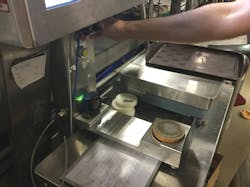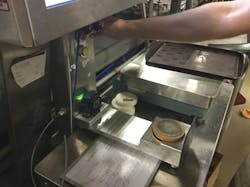Food Inspection: Vision sensor measures height of English muffins
Consistency is king at fast-casual restaurants such as McDonald's. Customers not only expect it, but practical reasons exist as well. For example, English muffins too thickly sliced may not easily fit into commercial toasters. Understanding this, Northeast Foods Inc (Baltimore, MD, USA;www.nefoods.com), an industrial bakery that produces millions of English muffins and soft sandwich rolls for fast-casual restaurants each day, must meet exact specifications including height, diameter, temperature and color. Specifications require that rolls be sliced 16 mm from the bottom with acceptable variances of 14 to 18 mm.
Formerly, to demonstrate compliance with these requirements, Northeast Foods took a manual approach, measuring qualities such as bun height at regular intervals during production, then recoding data in spreadsheets to share with clients. "Our operators are very committed to their work and to producing a high-quality product, but they're human, and everyone on the line used the micrometer a little differently," explains Jim Clouthier, corporate engineer at Northeast Foods. "I knew there must be a more reliable way to get the measurements we needed."
At the same time, Northeast Foods and McDonald's collaborated to implement a new statistical process control (SPC) system to automate data collection during production.
Clouthier consulted with Nick Pirog of CPU Automation (Westford, MA, USA), a company that works with manufacturers to plan, design, and integrate automation systems. Pirog recommended using machine vision to ensure the accuracy of measurements and designed an application that uses a BOA Spot vision sensor with iNspect Express software from Teledyne DALSA (Waterloo, ON, Canada;www.teledynedalsa.com).
With the BOA Spot, the integration of camera, lighting, optics, cabling, and software allowed Northeast Foods to deploy a vision solution to measure bun height for less than $2000. The BOA Spot incorporates camera technology, lighting, and iNspect Express software in an easy-to-use system can be seamlessly integrated with other production systems, including SPC software.
"Incorporating vision technology into production with Teledyne DALSA's BOA Spot gives us a degree of accuracy we couldn't achieve otherwise," Clouthier says. "The solution is simple and reliable, and provides the quality inspection we need. Plus, because the BOA Spot can provide data on other variables like a roll's profile or slope, we've been able to expand our inspection and make system adjustments to ensure even greater quality."
The vision sensor operates with iNspect Express software, which includes measurement tools to measure height at three locations across the roll and send the average value serially to Northeast Food's SPC system. Data is stored in the Cloud to be analyzed by both Northeast Foods and McDonald's.
Today, the Teledyne DALSA solution has been deployed at three of Northeast Food's production sites, and the company has future deployments planned at four more facilities. Clouthier notes that implementation of the BOA Spot at each facility has been unique as the vision solution is tailored to each production environment. In the most recent implementation, for example, a red light and filter were added to the BOA Spot to offset for variances in ambient lighting found at different locations in the factory environment. Northeast Foods has been using the BOA Spot for more than a year and the solution has helped ensure accuracy.
"Northeast Foods is committed to product quality, and we appreciate the validation the BOA Spot provides. Everyone on our team has confidence in the data we share with our clients," Clouthier says. "Using the BOA Spot has also helped streamline our inspection process and our operators have noted how quick and easy it is to use. Most importantly, incorporating a vision solution like the BOA Spot into our production processes has ensured that we're able to integrate seamlessly with the SPC system and provide our customer with the data that is important to their business."


